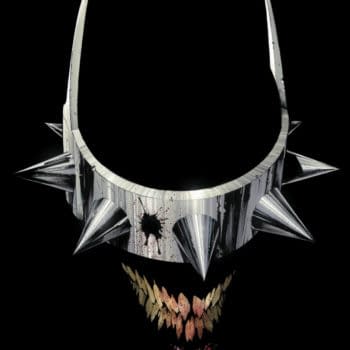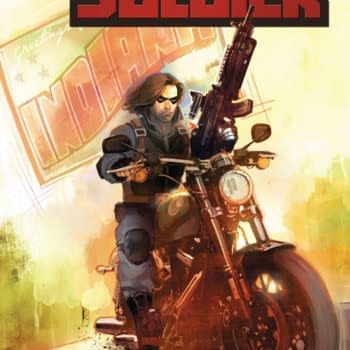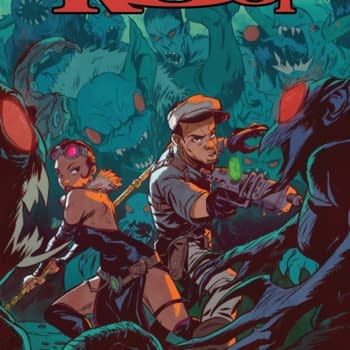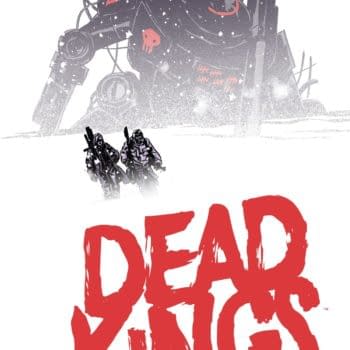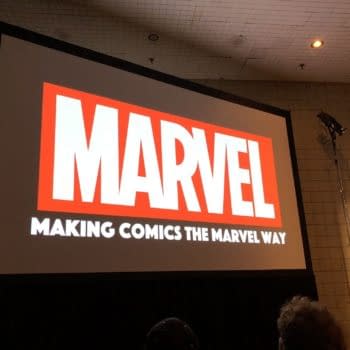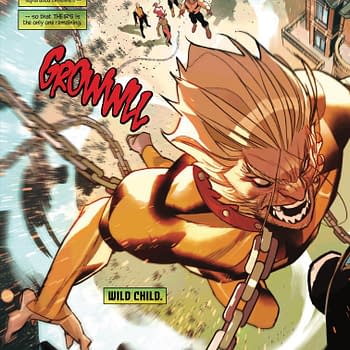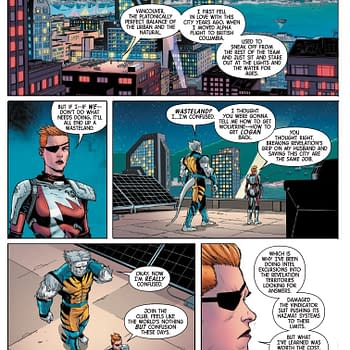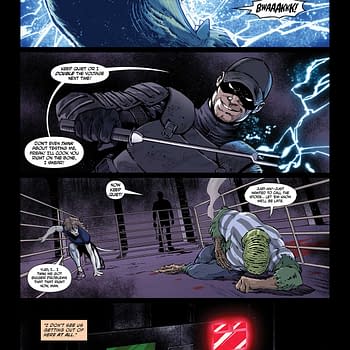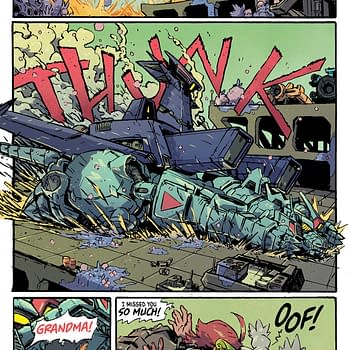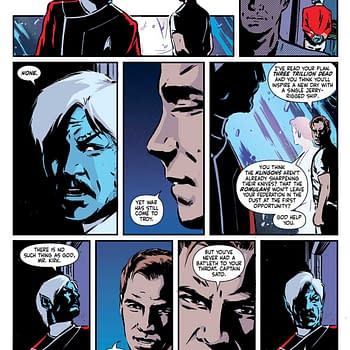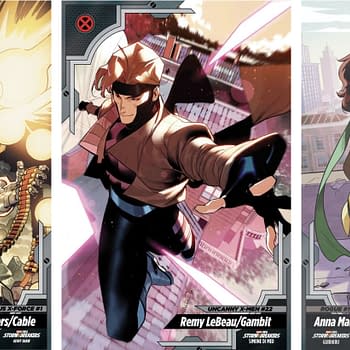Posted in: Comics, Conventions, NYCC, Spider-Man | Tagged: HRL, jack kirby, marvel, NYCC, spider-man, stan lee
Jack Kirby Walked Into Stan Lee's Office With An Idea: Spider-Man
Comics writer and blogger Mark Evanier celebrated Jack Kirby's centennial with Rand Hoppe and Tom Kraft, the curators at the Jack Kirby Museum at NYCC's 'Jack Kirby – King of Comics' panel this Sunday.
Evanier, a former assistant to Kirby, wrote the coffee-table book Kirby: King of Comics and is currently working on an exhaustive biography of the comics legend. He revealed the book will be released soon as he has sorted out the legal issues that were stalling the project.
Evanier very much dominated the panel, and started off by described his role working with Kirby: "I was an utterly useless assistant." He and his fellow assistant Steve Sherman would listen as Kirby would tell them the story he was going to draw, then they would "get the hell out of there" while Kirby worked his magic. As Evanier puts it, "I deserve massive credit for not doing anything at all on that material," though he does take credit for helping Kirby "get a better inker" (presumably he means Mike Royer).
He talked about how Kirby liked to inspire people, but did not like imitators, telling a story about Kirby's reaction to reading a comic news article where a new Marvel creator was quoted saying that he planned to do stories "in the Jack Kirby tradition". "The kid doesn't get it" was Kirby's reaction "the Kirby tradition is to create a brand new book". So that's potentially rough news for the legion of Kirby style artists out there such as Tom Scioli.
Evanier spoke about the essential humanity of Kirby, saying, "He would talk to anybody — everyone was an equal to him until they proved undeserving." As long as you seemed sincere, he said, Kirby would like you. And even when he was asked to critique fans' worst artwork, he would be very encouraging and tell them to keep at it.
Evanier said he felt smarter around him, and if you were to tell him an idea, "He would give you 25 ideas about your ideas! You would start to suspect, 'Has he been working on this already? Did he somehow hear my idea before?'"
He talked about how Kirby could create intricate stories on the spot, recounting when a fan asked Kirby at a con, "Where did Captain America get his shield came from?" "A comet," answered Kirby, and he proceeded to detail how Cap found the meteor and fashioned his shield from it. Evanier watched, realizing Kirby was making up this complex story on the spot.
"Sometimes we meet our heroes and they disappoint us," Evanier said, "but this never happened to anyone with Jack — except for anyone that expected him to be 6'4 and very muscular."
Rand Hoppe and Tom Kraft then spoke about how their Kirby Museum is virtual — it as yet has no permanent display space outside of the internet, but they have done several pop-up temporary exhibits "all 'round the world." They do a lot of scanning and reportedly have over 55,000 pages of original art in their archives — as well as all of Kirby's personal collection of photocopies of his work, donated to them by the Kirby family.
They talked about how the archive is a resource for publishers, and if you have read any of the Artist Edition full-size reproductions of Kirby's pencil art: "Most of that material comes from our archives."
While looking at a slide of Kirby's pencils, Evanier remarked that these Artist Edition reproductions show how much of the work did not have to be on those pages. "[Comic book printing] was always done by the cheapest method they could find," he said, and no publisher ever objected to cheaper method of printing for fear of reducing quality.
The original comics often had, as Evanier said, "a bad inker, bad colorist, poor printing process, and even some retouched art. But he said that many artists in Kirby's era could have spent less time on each page and decided not to — such was their commitment to the quality of the work.
Now that this material is being published faithfully, Evanier said, you can see all the nuances and subtle background details that Kirby put in there knowing full well they would probably be hidden from readers when first printed. "Jack knew it would be reprinted eventually — we didn't believe him, then it happened." Kirby was very prescient, and Evanier said it scares him: "Some of his predictions were apocalyptic about the future of mankind, and some of the less apocalyptian ones have already come to pass."
Evanier then asked the audience for questions, saying, "If you have a question about Jack and no one on this dais can answer it, then it can't be answered!"
He was asked about rumors regarding Kirby's work on the 1980s toy tie-in Super Powers books from DC — was some of the art ghosted (i.e. done by other uncredited artists in Kirby's style)?
"That rumour is not true," Evanier responded, saying that later on when he was ailing, Kirby had people who "helped him out a little on commissions — Jack actually had less assistants than anybody else who produced that much work — but nobody was ghosting for him."
Kirby reportedly did no rough sketches or doodles — "He just sat down and drew," Evanier said. He then compared Kirby's style of working to improv comedy — it was loose and spontaneous. "It came out of him without a lot of planning." In improv, they teach you to produce material fluidly, like a stream of consciousness, and Evanier says Kirby would work the same way. "[He could] finish an issue of Miracle Man at 2:30 and start a Forever People book at 3 p.m. [It was all] created right in front of you and very fast." He would think of picture or scene and just draw it, Evanier said.
Kirby would only "use the eraser to remove a panel — not to improve it, but to change it," Evanier said. Working as his assistant, Evanier would frequently be surprised by the finished work, as it might not resemble at all the story Kirby had said he was going to draw. Kirby would often be taken in a very different direction as he drew.
Evanier compared Kirby's approach to Milt Caniff, who would "spot the blacks and lead your eye through the strip — Kirby would approach the page in the same way."
A questioner asked: how well read was Kirby? "He read everything," Evanier said. "[He was] a very knowledgeable and smart man." Apparently, people didn't appreciate his intelligence because he spoke in with a Brooklyn street accent and used his hands a lot while talking. He also talked in a roundabout way, as Evanier points out: "He would say something to me that I wouldn't understand until I later realized he was finishing a conversation we had two weeks ago."
Evanier recounted Kirby describing an idea to him: "What if Captain Marvel did this?" But the plot made no sense and featured Marvel doing inappropriate things — until Kirby mentioned as part of the plot, "Then the Red Skull does this." Evanier realized, "He got just one word wrong – it was a great Captain America plot."
Evanier was asked for his opinion on Vince Colletta — was he a good inker on Kirby? "I think that Vince Colletta was not the right inker for Jack Kirby," was his reply.
Evanier then talked about how collaborators were assigned to work together for practical reasons — whoever was available – rather than artistic ones. He recounted a story about Chic Stone, who did not like inking other peoples work — but he was looking for work for work at Marvel Comics and Stan Lee didn't like his pencils. Stan had an issue of Thor ready to be sent to George Roussos to ink and asked him to take a look. Stone apparently saw the "subtlety and power" of the work and thought it was the best penciling he'd ever seen. He initially said no, but was convinced by Stan and wound up inking a lot of Kirby's work.
Then there was a question about the origin of photo montage in Kirbys's work — Evanier digressed in replying, talking at first about the contrast between John Buscema and Kirby's Silver Surfer and the debate about which version is superior. "Jack was not doing same thing as Buscema — he was always looking to take comics to the next stage."
He then told a story about how Jack would use images from Playboy magazine in his collages. Kirby had a subscription to Playboy — given to him by the company because Harvey Kurtzman wanted him to do sexy Barbarella-type strip for the title. He hid them from his daughters in a corner in his studio, and one day told Evanier that he should take them. Evanier looked at them and saw that pages and been torn out and cut up — Jack had been using them for his collages — "so somewhere in there's a woman's thigh as a bridge to Asgard."
Another question: which artists influenced him and which contemporaries did he admire?
"He liked everyone," replied Evanier. "He wasn't competitive or jealous at all." He recounted another story — a fan approached Kirby and told him, "I think you are the greatest comic book artist." "I thank you," was Kirby's reply (he always replied "I thank you" to any compliment, said Evanier). Then the fan said, "Except Gil Kane, of course. He's the best." Kirby just replied, "Yeah! Gil's terrific!"
Evanier said that Kirby admired many of contemporaries, singling out Bill Everett, Steve Ditko, Don Heck, and Wally Wood – "He loved [Alex] Toth." He once commented, "I don't know why Marie Severin is not working for Mad magazine — she does amazing caricatures." This was true, though they were "usually insulting caricatures of her employers," noted Evanier.
Kirby thought Don Heck drew "the best women" and "John Severin, the best war scenes."
He was influenced by many comic strip artists such as Alex Raymond, Milton Caniff, and Hal Foster — and Evanier singled out one obscure strip: Red Barry by Will Gould, which he thinks had a particular influence on Kirby.
Although Kirby didn't look at a lot of other comics, he was always interested in new artists, and the only stuff he did not like was anything "derivative" or "slopped out without care." Evanier recounted Kirby in his older years meeting a young artist and exclaiming, "Isn't it great!?" while talking about their profession.
Did Evanier ever pitch a project at Kirby? Jack's wife Roz approached him and said, "Why don't you work with Jack?" So Evanier came up with an idea. Kirby "went nuts" with more ideas for it, "enough for the series, the first two annuals, and for spinoffs," when Evanier described it to him.
They approached Terry Austin to ink the book – he agreed and said, "Yeah whatever it is, I'll do it." Evanier began to set the project up with Archie Goodwin, who at the time was the editor of Epic at Marvel. Goodwin was "the most honest person in comics," but as Kirby's health deteriorated, Evanier began to have doubts about the project.
Kirby had a difficult relationship with Marvel, and Evanier worried about what would happen to the project if Goodwin was to leave the company. So Evanier ultimately decided to abandon it. He thinks he dodged a bullet, because Goodwin subsequently did leave, and Evanier's other project with Epic — Hollywood Superstars — was cancelled by the new editors.
The panel was asked about Kirby's relationship with legendary creator Will Eisner, and Evanier responded that Kirby always referred to Eisner as Bill Eisner — "Anyone who knew Eisner in the '40s would call him that." He continued: "Jack loved Eisner; he thought world of him, but never really thought the feelings were reciprocal."
Why did Kirby not produce graphic novels like Eisner in his later years?
Jack was a "depression-era creator" to whom it was always important to provide for his family: "Jack looked for guaranteed paycheck and had no offers to create GNs that would have paid him to do this."
The only time he had an opportunity to do that was when Richard Kyle gave him a budget for a 14-page story and Street Code, one of Kirby's most personal works, is the product of that. In later years Kirby was focused on saving so he could leave money for his wife Roz, because he apparently knew he'd die before she did. And the best way he could do that was by creating Silver Surfer commissions.
Evanier was asked about the perennial controversy over whether and to what extent Kirby was involved in the creation of Spider-Man.
"I believe Jack walked in Stan Lee's office and suggested that they do a character called Spider-Man, who climbs buildings, walks on walls, etc." Stan may have also had the idea simultaneously — but Evanier definitely believes Jack came up with it himself — he has seen a title logo that Kirby made years earlier.
The plot involved a teenager who turned into a superhero – "Billy Batson/ Captain Marvel style." However, even more than Captain Marvel the story resembles an older Kirby creation: Tommy Troy/ The Fly — the Archie/MLJ character. Evanier believes Steve Ditko may have been the one to notice the similarity — Ditko having worked on the original Fly series after Kirby.
This led Lee to abandon Kirby's approach to the character — while Archie may not sue "Joe Simon [The Fly's co-creator with Kirby] definitely would" according to Evanier. Lee's explanation, that he thought Kirby's Spider-Man was too big and muscly, is belied by the fact that Lee used Kirby extensively on the character in his early issues — often replacing Ditko's Spider-Man drawings with Kirby's figures on early covers.
The project was then restarted with Ditko, who Evanier believes is responsible for designing Spider-Man's distinctive costume. However, Evanier maintains that many elements in Spider-Man's origin — the fact that the protagonist is a teenager, the burglar plot, and the whole moral of 'great power comes great responsibility' are present in Kirby's original plot. He said that 30 pages in his upcoming biography of Kirby are devoted to this topic.
So what would Kirby think of all the recent enormous success of superhero movies?
"He would say, 'I told you so!'" responded Evanier. "He told me that you can take any issue of Thor and use it as a storyboard for a movie, and that's just what they have done."
Finally, an audience member asked about the tumblr page Kirby WIthout Words, which shows Kirby's stories without any text — often the stories seem very different when viewed that way, with a common theme being the female characters are much more powerful and assertive.
Evanier said that this happened often: "Sometimes Stan and Jack were telling different stories. Jack intended Hulk to be a lot smarter." But interestingly, Evanier believes Kirby wasn't always right: "Stan is a very clever guy and had a lot of interesting ideas."




